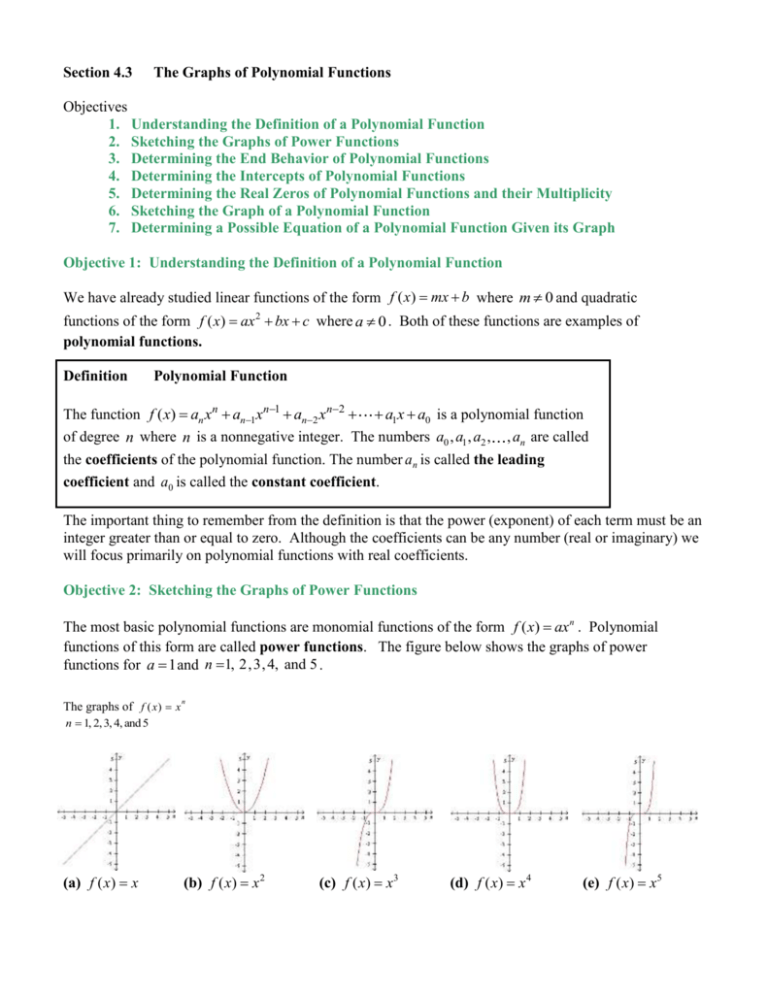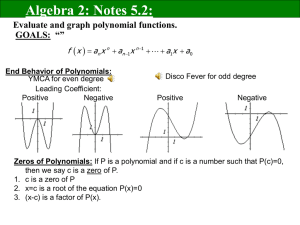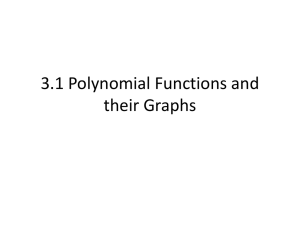4.3 SS
advertisement

Section 4.3 The Graphs of Polynomial Functions Objectives 1. Understanding the Definition of a Polynomial Function 2. Sketching the Graphs of Power Functions 3. Determining the End Behavior of Polynomial Functions 4. Determining the Intercepts of Polynomial Functions 5. Determining the Real Zeros of Polynomial Functions and their Multiplicity 6. Sketching the Graph of a Polynomial Function 7. Determining a Possible Equation of a Polynomial Function Given its Graph Objective 1: Understanding the Definition of a Polynomial Function We have already studied linear functions of the form f ( x) mx b where m 0 and quadratic functions of the form f ( x) ax 2 bx c where a 0 . Both of these functions are examples of polynomial functions. Definition Polynomial Function The function f ( x) an xn an1xn1 an2 xn2 a1x a0 is a polynomial function of degree n where n is a nonnegative integer. The numbers a0 , a1 , a2 , , an are called the coefficients of the polynomial function. The number an is called the leading coefficient and a0 is called the constant coefficient. The important thing to remember from the definition is that the power (exponent) of each term must be an integer greater than or equal to zero. Although the coefficients can be any number (real or imaginary) we will focus primarily on polynomial functions with real coefficients. Objective 2: Sketching the Graphs of Power Functions The most basic polynomial functions are monomial functions of the form f ( x) ax n . Polynomial functions of this form are called power functions. The figure below shows the graphs of power functions for a 1 and n 1, 2,3, 4, and 5 . The graphs of f ( x ) x n n 1, 2, 3, 4, and 5 (a) f ( x) x (b) f ( x) x 2 (c) f ( x) x3 (d) f ( x) x 4 (e) f ( x) x5 Note that the graph of f ( x) x 4 closely resembles the graph of f ( x) x 2 . The difference in the two graphs is that the graph of f ( x) x 4 flattens out near the origin and gets steeper quicker than the graph of f ( x) x 2 . Likewise, the graph of f ( x) x5 resembles the graph of f ( x) x3 . In general if n is even, the graph of f ( x) x n will resemble the graph of f ( x) x 2 . If n is odd, the graph of f ( x) x n will resemble the graph of f ( x) x3 . Because we know the basic shape of f ( x) x n , we can use the transformation techniques discussed in Section 3.4 to sketch more complicated polynomial functions. Objective 3: Determining the End Behavior of Polynomial Functions In order to begin to sketch the graph of a more complicated polynomial function, it is necessary to understand the behavior of the graph as the x-coordinate gets large in the positive direction (approaches infinity) and as the x-coordinate gets small in the negative direction (approaches negative infinity). The nature of the graph of a polynomial function for large values of x in the positive and negative direction is known as the end behavior. The end behavior of the graph of a polynomial function depends on the leading term, that is, the term of highest degree. The graph of a polynomial function f ( x) an xn an1xn1 an2 xn2 a1x a0 has the same end behavior as the graph of the power function f ( x) an xn . To illustrate end behavior, consider the polynomial function f ( x) x5 2 x 4 6 x3 8 x 2 5 x 6 sketched on the left and compare it to the graph of f ( x) x5 sketched on the right in the figure below. Notice that the “ends” of both graphs have similar behavior. The right-hand ends of both graphs increase without bound, that is, the y-values approach infinity as the x-values approach infinity. The left-hand ends of both graph approach negative infinity as the x-values approach negative infinity. The right-hand ends of both graphs approach infinity as the x-values approach infinity. The left-hand end of both graphs approach negative infinity as the x-values approach negative infinity. Two-Step Process for Determining the End Behavior of a Polynomial Function f ( x ) an x n an1 x n1 an2 x n2 a1 x a0 . Step 1: Determine the sign of the leading coefficient an : If an 0 , the right-hand behavior “finishes up.” If an 0 , the right-hand behavior “finishes down.” Right-hand end of graph finishes in an upward direction if an 0. Right-hand end of graph finishes in a downward direction if an Step 2: Determine the degree If the degree n is odd, the graph has opposite left-hand and right-hand end behavior, that is, the graph “starts” and “finishes” in opposite directions. Odd degree polynomials have opposite left-hand and right-hand end behavior. an 0 , odd degree an 0 , odd degree If the degree n is even, the graph has the same left-hand and right-hand end behavior, that is, the graph “starts” and “finishes” in the same direction. Even degree polynomials have the same left-hand and right-hand end behavior. an 0 , even degree an 0 , even degree 0. Objective 4: Determining the Intercepts of a Polynomial Function Now that we know how to determine the end behavior of a polynomial function, it is time to find out what happens between the ends. We start by trying to locate the intercepts of the graph. Every polynomial function, y f ( x) , has a y-intercept which can be found by evaluating f (0) . Locating the x-intercepts is not always an easy task. Recall that the number x c is called a zero of a function f if f (c) 0 . If c is a real number, then c is an x-intercept. Therefore, to find the x-intercepts of a polynomial function y f ( x) , we must find the real solutions of the equation f ( x) 0 . Objective 5: Determining the Real Zeros of Polynomial Functions and Their Multiplicities In general, if x c is a factor of a polynomial function then x c is a zero. The converse of the previous statement is also true. (If f is a polynomial function and x c is a zero then x c is a factor.) For example, consider the polynomial functions f ( x) ( x 1) 2 and g ( x) x 1 . Both functions have 3 a real zero at x 1 since ( x 1) is a factor of both polynomials. For the function f ( x) ( x 1) 2 , x 1 is called a zero of multiplicity two since the factor ( x 1) occurs two times in the factorization of f. Likewise, for g ( x) x 1 , x 1 is a zero of multiplicity 3. Notice below that the graph of 3 f ( x) ( x 1) 2 is tangent to (touches) the x-axis at x 1 while the graph of g ( x) x 1 crosses the x3 axis at x 1 . The graph of a polynomial function will touch the x-axis at a real zero of even multiplicity and will cross the x-axis at a real zero of odd multiplicity. f ( x) ( x 1)2 Graph will touch the x-axis at a real zero with even multiplicity. f ( x) ( x 1)3 Graph will cross the x-axis at a real zero with odd multiplicity. The Shape of the Graph of a Polynomial Function Near a Zero of Multiplicity k. Suppose c is a real zero of a polynomial function f of multiplicity k, that is, x c is a factor of f. Then the shape of the graph of f near c is as follows: k If k 1 is even, then the graph touches the x-axis at c. OR If k 1 is odd, then the graph crosses the x-axis at c. OR Objective 6: Sketching the Graph of a Polynomial Function By determining the end behavior of this function and by plotting the x-intercepts and y-intercept, we can begin to sketch the graph of a polynomial function. y-intercept Graph has opposite end behavior since the degree is odd. Graph "ends up" since the leading coefficient is positive. The graph must cross the x-axis at each x-intercept. To complete the graph, we can create a table of values to plot additional points by choosing a test value between each of the zeros. A polynomial of degree n has at most n 1 turning points. A turning point in which the graph changes from increasing to decreasing is also called a local maximum. A turning point in which the graph changes from decreasing to increasing is called a local minimum. Without the use of calculus (or a graphing utility) there is no way to determine the precise coordinates of the local minima and local maxima. We can summarize the sketching procedure with the following four-step process. Four-Step Process for Sketching the Graph of a Polynomial Function 1. Determine the end behavior. 2. Plot the y-intercept f (0) a0 . 3. Completely factor f to find all real zeros and their multiplicities*. 4. Choose a test value between each real zero and sketch the graph. (Remember, without calculus, there is no way to precisely determine the exact coordinates of the turning points.) * This is the most difficult step and will be discussed in further detail in the subsequent sections of this chapter. Objective 7: Determining a Possible Equation of a Polynomial Function Given its Graph Now that we have identified the characteristics of a polynomial function and can create an approximate sketch of its graph, we should be able to analyze the graph of a polynomial function and describe features of its equation. The end behavior of the graph gives us information about the degree and leading coefficient, the y-intercept gives us the value of the constant coefficient, and the behavior of the graph at the x-intercepts gives us information about the multiplicity of the zeros. We can use all of this information to identify possible equations that the graph of a polynomial function might represent.









